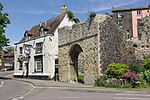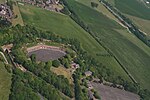Dover Castle
Anthony Salvin buildingsCastles in KentEnglish Heritage sites in KentForts in Dover, KentGrade I listed buildings in Kent ... and 13 more
Grade I listed castlesHistory museums in KentInvasions of EnglandMilitary and war museums in EnglandMilitary history of Dover, KentNapoleon's planned invasion of the United KingdomNapoleonic war forts in EnglandNorman conquest of EnglandPrincess of Wales's Royal RegimentScheduled monuments in KentTourist attractions in KentUse British English from June 2015World War II museums in the United Kingdom

Dover Castle is a medieval castle in Dover, Kent, England and is Grade I listed. It was founded in the 11th century and has been described as the "Key to England" due to its defensive significance throughout history. Some writers say it is the largest castle in England, a title also claimed by Windsor Castle.
Excerpt from the Wikipedia article Dover Castle (License: CC BY-SA 3.0, Authors, Images).Dover Castle
Castle Hill Road,
Geographical coordinates (GPS) Address Nearby Places Show on map
Geographical coordinates (GPS)
| Latitude | Longitude |
|---|---|
| N 51.1297 ° | E 1.3214 ° |
Address
The Great Tower
Castle Hill Road
CT16 1HU , Tower Hamlets
England, United Kingdom
Open on Google Maps











